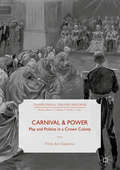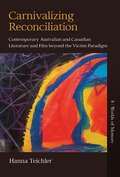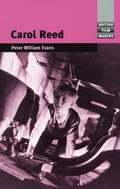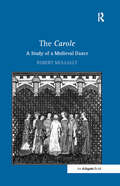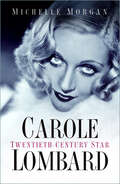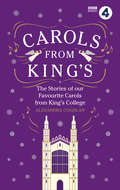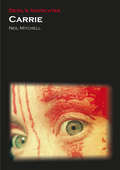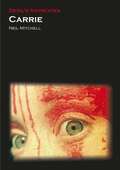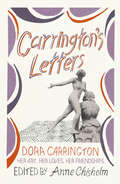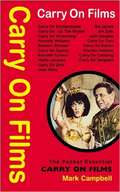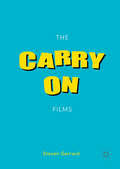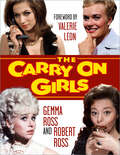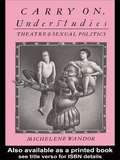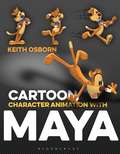- Table View
- List View
Carnival and Power: Play and Politics in a Crown Colony
by Vicki Ann CremonaThis book shows how Carnival under British colonial rule became a locus of resistance as well as an exercise and affirmation of power. Carnival is both a space of theatricality and a site of politics, where the playful, participatory aspects are appropriated by countervailing forces seeking to influence, control, channel or redirect power. Focusing specifically on the Maltese islands, a tiny European archipelago situated at the heart of the Mediterranean, this work links the contrast between play and power to other Carnival realities across the world. It examines the question of power and identity in relation to different social classes and environments of Carnival play, from streets to ballrooms. It looks at satire and censorship, unbridled gaiety and controlled celebration. It describes the ways Carnival was appropriated as a power channel both by the British and their Maltese subjects, and ultimately how it was manipulated in the struggle for Malta’s independence.
Carnival to Catwalk: Global Reflections on Fancy Dress Costume
by Benjamin Linley WildFrom West African masquerades to Venetian carnivals and New York society galas, fancy dress has long been used to convey important social and political messages. The only form of clothing that all people, regardless of gender, race, class or sexuality are likely to wear at some point in their lives, fancy dress is a symbol of both escapism and protest; it stands for a vision of fantasy and fun, while also confronting the reality of cultural stereotypes.Exploring all the allure, playfulness and daring of dressing up, Carnival to Catwalk takes the reader on a fascinating journey through the global history of fancy dress. Drawing on a treasure-trove of textual and visual resources, the book encompasses Halloween festivities and transvestite clubs, Mardi Gras parades and gatherings at Versailles, revealing how fancy dress has long been used to celebrate as well as to disguise individual identity.Vividly chronicling evidence from the Middle Ages to the modern day, cultural historian Benjamin Wild throws open the historical dressing-up box and demonstrates the enduring appeal of fancy dress, as it becomes an increasingly central part of modern couture and clothing design. Meticulously researched and beautifully illustrated, Carnival to Catwalk is a remarkable resource for scholars, students and costume enthusiasts alike.
Carnival to Catwalk: Global Reflections on Fancy Dress Costume
by Benjamin Linley WildFrom West African masquerades to Venetian carnivals and New York society galas, fancy dress has long been used to convey important social and political messages. The only form of clothing that all people, regardless of gender, race, class or sexuality are likely to wear at some point in their lives, fancy dress is a symbol of both escapism and protest; it stands for a vision of fantasy and fun, while also confronting the reality of cultural stereotypes.Exploring all the allure, playfulness and daring of dressing up, Carnival to Catwalk takes the reader on a fascinating journey through the global history of fancy dress. Drawing on a treasure-trove of textual and visual resources, the book encompasses Halloween festivities and transvestite clubs, Mardi Gras parades and gatherings at Versailles, revealing how fancy dress has long been used to celebrate as well as to disguise individual identity.Vividly chronicling evidence from the Middle Ages to the modern day, cultural historian Benjamin Wild throws open the historical dressing-up box and demonstrates the enduring appeal of fancy dress, as it becomes an increasingly central part of modern couture and clothing design. Meticulously researched and beautifully illustrated, Carnival to Catwalk is a remarkable resource for scholars, students and costume enthusiasts alike.
Carnivalizing Reconciliation: Contemporary Australian and Canadian Literature and Film beyond the Victim Paradigm (Worlds of Memory #8)
by Hanna TeichlerCriminal justice inquiries may be the most historically dramatic means for coming to terms with traumatic legacies, but it is in the more subtle social and cultural processes of “memory work” that most individuals encounter historical reconciliation in practice. This book analyzes, within the realms of national literature and film, recent Australian and Canadian attempts to reconcile with Indigenous populations in the wake of forced child removal. As Hanna Teichler demonstrates, their systematic emphasis on the subjectivity of the victim is “carnivalesque,” temporarily overturning discursive hierarchies. Such fictions of reconciliation venture beyond simplistic narratives and identities defined by victimization, offering new opportunities for confronting painful histories.
Carol Reed (British Film-Makers)
by Peter William EvansCarol Reed is one of the truly outstanding directors of British cinema, and one whose work is long overdue for reconsideration. This major study ranges over Reed’s entire career, combining observation of general trends and patterns with detailed analysis of twenty films, both acknowledged masterpieces and lesser-known works. Evans avoids a simplistic auteurist approach, placing the films in their autobiographical, socio-political and cultural contexts and relating these to the analysis of Reed’s art. The critical approach combines psychoanalysis, gender theory, and the analysis of form. Archival research is also relied on to clarify Reed’s relations with his creative team, financial backers and others. Films examined include Bank Holiday, A Girl Must Live, Odd Man Out, The Fallen Idol, The Third Man, Night Train to Munich, The Way Ahead, Outcast of the Islands, Trapeze and Oliver!.
The Carole: A Study of a Medieval Dance
by Robert MullallyThe carole was the principal social dance in France and England from c. 1100 to c. 1400 and was frequently mentioned in French and English medieval literature. However, it has been widely misunderstood by contributors in recent citations in dictionaries and reference books, both linguistic and musical. The carole was performed by all classes of society - kings and nobles, shepherds and servant girls. It is described as taking place both indoors and outdoors. Its central position in the life of the people is underlined by references not only in what we might call fictional texts, but also in historical (or quasi-historical) writings, in moral treatises and even in a work on astronomy. Dr Robert Mullally's focus is very much on details relevant to the history, choreography and performance of the dance as revealed in the primary sources. This methodology involves attempting to isolate the term carole from other dance terms not only in French, but also in other languages. Mullally's groundbreaking study establishes all the characteristics of this dance: etymological, choreographical, lyrical, musical and iconographical.
The Carole: A Study of a Medieval Dance
by Robert MullallyThe carole was the principal social dance in France and England from c. 1100 to c. 1400 and was frequently mentioned in French and English medieval literature. However, it has been widely misunderstood by contributors in recent citations in dictionaries and reference books, both linguistic and musical. The carole was performed by all classes of society - kings and nobles, shepherds and servant girls. It is described as taking place both indoors and outdoors. Its central position in the life of the people is underlined by references not only in what we might call fictional texts, but also in historical (or quasi-historical) writings, in moral treatises and even in a work on astronomy. Dr Robert Mullally's focus is very much on details relevant to the history, choreography and performance of the dance as revealed in the primary sources. This methodology involves attempting to isolate the term carole from other dance terms not only in French, but also in other languages. Mullally's groundbreaking study establishes all the characteristics of this dance: etymological, choreographical, lyrical, musical and iconographical.
Carole Lombard: Twentieth-Century Star
by Michelle MorganCarole Lombard was the very opposite of the typical 1930s starlet. A no-nonsense woman, she worked hard, took no prisoners and had a great passion for life. As a result, she became Hollywood’s highest-paid star. From the outside, Carole’s life was one of great glamour and fun, yet privately she endured much heartache. As a child, her mother moved Carole and her brothers across the country away from their beloved father. Carole then began a film career, only to have it cut short after a devastating car accident. Picking herself back up, she was rocked by the accidental shooting of her lover; a failed marriage to actor William Powell; and the sorrow of infertility during her marriage to Hollywood’s King, Clark Gable. Lombard marched forward, promising to be positive. Sadly her life was cut short in a plane crash so catastrophic that pieces of the aircraft are still buried in the mountain today. In Carole Lombard, bestselling author Michelle Morgan accesses previously unseen documents to tell the story of a woman whose remarkable life and controversial death continues to enthral.
Carols From King's
by Alexandra CoghlanThe exquisite sound of a lone chorister singing Once in Royal David’s City amid the candlelit chapel of King’s College, Cambridge, marks the start of the Christmas festivities for millions of people round the globe. Broadcast at 3pm on Christmas Eve, A Festival of Nine Lessons and Carols provides a precious moment of tranquillity amongst the bustle of the festive season. Take a journey through the fascinating history of carols, from the very first - sung by the angels to the shepherds at Bethlehem - to anecdotes from contemporary King's choristers. Learn how carols have evolved from pagan songs to become one of our nation's most sacred treasures. Accompanied by lyrics and music and compiled in conjunction with Radio 4 and King’s College Chapel, Carols From King’s is the official companion for fans of Christmas and carols alike.
Carrie (Devil's Advocates)
by Neil MitchellBrian De Palma's adaptation of Stephen King's debut novel, Carrie (1976), is one of the defining films of 1970s "New Hollywood" style and a horror classic. The story of a teenage social outcast who discovers she possesses latent psychic powers that allow her to deliver retribution to her peers, teachers, and abusive mother, Carrie was an enormous commercial and critical success and is still one of the finest screen adaptations of a King novel. This contribution to the Devil's Advocates series not only breaks the film down into its formal componenets--its themes, stylistic tropes, technical approaches, uses of color and sound, dialogue, and visual symbolism--but also considers a multitude of other factors contributing to the work's classic status. The act of adapting King's novel for the big screen, the origins of the novel itself, the place of Carrie in De Palma's oeuvre, the subsequent versions and sequel, and the social, political, and cultural climate of the era (including the influence of second wave feminism, loosening sexual norms, and changing representations of adolescence), as well as the explosion of interest in and the evolution of the horror genre during the decade, are all shown to have played an important part in the film's success and enduring reputation.
Carrie (Devil's Advocates)
by Neil MitchellBrian De Palma's adaptation of Stephen King's debut novel, Carrie (1976), is one of the defining films of 1970s "New Hollywood" style and a horror classic. The story of a teenage social outcast who discovers she possesses latent psychic powers that allow her to deliver retribution to her peers, teachers, and abusive mother, Carrie was an enormous commercial and critical success and is still one of the finest screen adaptations of a King novel. This contribution to the Devil's Advocates series not only breaks the film down into its formal componenets--its themes, stylistic tropes, technical approaches, uses of color and sound, dialogue, and visual symbolism--but also considers a multitude of other factors contributing to the work's classic status. The act of adapting King's novel for the big screen, the origins of the novel itself, the place of Carrie in De Palma's oeuvre, the subsequent versions and sequel, and the social, political, and cultural climate of the era (including the influence of second wave feminism, loosening sexual norms, and changing representations of adolescence), as well as the explosion of interest in and the evolution of the horror genre during the decade, are all shown to have played an important part in the film's success and enduring reputation.
Carrington's Letters: Her Art, Her Loves, Her Friendships
by Anne Chisholm Dora Carrington‘Your letters are a great pleasure. I lap them down with breakfast and they do me more good than tonics, blood capsules or iron jelloids’ Lytton StracheyDora Carrington was considered an outsider to Bloomsbury, but she lived right at its heart. Known only by her surname, she was the star of her year at the Slade School of Fine Art, but never achieved the fame her early career promised. For over a decade she was the companion of homosexual writer Lytton Strachey, and killed herself, stricken without him, when he died in 1932. She was also a prolific and exuberant correspondent.Carrington was not consciously a pioneer or a feminist, but in her determination to live life according to her own nature – especially in relation to her work, her passionate friendships and her fluid attitude to sex, gender and sexuality – she fought battles that remain familiar and urgent today. She was friends with the greatest minds of the day and her correspondence stars a roster of fascinating characters – Virginia Woolf, Vanessa Bell, Rosamund Lehmann, Maynard Keynes to name but a few.Carrington’s Letters introduces the maverick artist and compelling personality to a new generation for the first time with fresh correspondence never before published. Unmediated, passionate, startlingly honest and very playful, reading Carrington’s letters is like having her whisper in your ear and embrace you gleefully.
Carry a Big Stick: A funny, fearless life of friendship, laughter and MS
by Tim FergusonA funny, poignant and inspirational story of widely acclaimed comedian, writer and producer, Tim Ferguson.Tim Ferguson was a star of the international comedy circuit. Along with Paul McDermott and Richard Fidler he was part of the edgy, provocative and very funny Doug Anthony Allstars (DAAS). In 1994 they were at the height of their powers, performing in a season at the Criterion Theatre on Piccadilly Circus. The three mates, who began busking on the streets of Canberra a decade earlier, had achieved their ambition to become the self-styled rock stars of comedy.Then, all of a sudden, Tim woke up one morning and his whole left side wouldn't work. He'd had a lurking suspicion that something was wrong and after more episodes he went to a doctor thinking he'd be told to change his diet and get more sleep. It wasn't so simple. An eventual diagnosis of multiple sclerosis (MS) meant an end to the frenetic, high-energy life he was living.Carry a Big Stick is a chance for Tim to tell his story. He wants to make people laugh but also give inspiration to all the people doing it hard. A lot of people keep MS to themselves because it's invisible. In Tim's case, he has the stick. 'It's such a visible sign that something's happened; it's just easier if people know.'Carry a Big Stick meanders through Tim's life, and explains how the boy who went to nine schools in 13 years got used to saying, 'Hi, I'm the new kid'. It will detail his ambitions to become an actor and how the Doug Anthony Allstars were born and went on to become what Rolling Stone called 'The 3 amigos from hell'. Diagnosis changed a lot of things but Tim's quick wit and sense of humour weren't affected. This inspiring memoir shows us that you can laugh in the face of adversity.
Carry On Films: An Introduction to the British Comedy Phenomenon
by Mark CampbellInfamy! Infamy! They've All Got It In For Me! Beginning with the feel-good conscription caper Carry On Sergeant (1958) and finishing up with the much-maligned sex farce Carry On Emmannuelle (1978), producer Peter Rogers and director Gerald Thomas tossed off a record-breaking thirty films, all with that unique 'naughty but nice' seaside postcard-style humour. A team of spot-on comedy performers, headed by Kenneth Williams, Sid James, Charles Hawtrey, Hattie Jacques and Kenneth Connor, provided the great unwashed public with brain-achingly corny gags, ridiculous slapstick antics and seminal scenes of mayhem and speeded-up chicanery that would have brought a smile to the most jaded of palates. The Carry On comedy partnership of Rogers and Thomas (later combined with the wit of scriptwriter Talbot Rothwell) was responsible for many a classic production. From historicals such as Carry On Cleo (1964) and Carry On...Up The Khyber (1968) - the latter quite possibly the funniest film ever made in Wales - to such contemporary rib-ticklers as Carry On Doctor (1967) and - possibly the most famous entry of all, thanks to Barbara Windsor's elasticised brassiere - the seminal Carry On Camping (1968). The series may have ended in the gutter with Carry On Behind (1975) and Carry On England (1976), but such was the sheer talent on display throughout those twenty years, we can forgive them this small failing. Any genre was up for ridicule - bored with Lawrence Of Arabia (1962)? Try Carry On...Follow That Camel (1967). Fed up with Hammer horror? Turn off the light and shudder at the spine-chilling Carry On Screaming! (1966). Everyone has a personal favourite Carry On film - look up yours in this concise introduction to the whole, extraordinary phenomenon. What's in it? Every film examined in detail, with full cast and crew listing, key scenes and dialogue gems, and an informed critique; brief biographies of the major players, TV shows and theatre plays; appendices that include an exhaustive bibliography and an overview of the best Carry On websites around; all rounded off with a fiendish quiz on all things Carry On.
The Carry On Films
by Steven GerrardSaucy, rude and vulgar—the 31 Carry On films remain an important part of the history of British cinematic and low brow comedy. In this book, Gerrard discusses the Carry On roots in the music halls of the Victorians and the saucy seaside postcards of Donald McGill. Made in post-war Britain, these films reflect a remarkable period of social change as the British Empire faded and a nation learned to laugh at itself. Nothing was sacred to the Carry On team. James Bond and Cleopatra were mercilessly lampooned, Miss World competitions and toilet factories came in for a cinematic pasting, while Sid James’ laugh, Barbara Windsor’s wiggle, Kenneth Williams’ flared nostrils and Charles Hawtrey’s “Oh, hello!” became synonymous with laughter, merriment and fun. Gerrard’s work examines the Carry On films as part of a wider canvas linking both their heritage and tradition to the contextual world they mirrored. The Carry On Films is an essential read for Carry On fans the country through.Ding dong! Carry On!
The Carry On Girls
by Gemma Ross Robert RossFar more than mere eye candy, these in-control, hard-working, and pioneering ladies were an early and earnest manifestation of Girl Power in the British film industry. This book will provide an invaluable celebration of the highly talented and forever decorative screen sirens that bewitched Carry On heroes Sid James, Kenneth Connor, Leslie Phillips, Bernard Bresslaw, Jim Dale, Peter Butterworth and, yes, even, Kenneth Williams.Through never-before-seen publicity material, exclusive interviews with the girls themselves and affectionate biographies by Carry On historian Robert Ross, this will be the most thumbed coffee table book ever to hit your coffee table!Soap opera favourites Amanda Barrie (Alma in Coronation Street) and Wendy Richard (Pauline Fowler in EastEnders), Bond girls Margaret Nolan, Madeline Smith and the Goldfinger star herself, Shirley Eaton, as well as international glamour stars Elke Sommer and Dany Robin, will be featured in candid interviews and stunning portrait shots.This book will be a long overdue salute to dozens of beloved Carry On actresses, from the courageous Liz Fraser to the ill-fated Imogen Hassall, and from the national treasure Barbara Windsor to the unfairly forgotten Sally Douglas. Each with a poignant and personal memory from fellow Carry On legend Valerie Leon, who will provide her unique and exclusive commentary.The book will also investigate the continuing cult of the Carry On girl, from Daniella Westbrook’s Carry On London photographic sessions to Page 3 girl Malene Espensen paying tribute to the Carry On Camping bra-burst of Barbara Windsor. All done in the best possible taste, of course, with the affection and joy that still makes the Carry On films the eternal toast of ITV3 and BritBox.The book will feature a wealth of illustrations ranging from cheesecake shots for Tit-Bits to relaxed behind-the-scenes poses with Carry On filmmakers Peter Rogers and Gerald Thomas and comedy legends such as Phil Silvers, Harry H. Corbett, Bob Monkhouse and Bernard Cribbins.Full of intimate tales from the soundstages of Pinewood Studios, snapshots of a lost industry and oodles of laughs, this is the ultimate tribute to a fun-filled era when British crumpet was at its spiciest!
Carry on Understudies: Theatre and Sexual Politics
by Michelene Wandor`one hell of a seminal read ... Here is a book that grapples, with energy, ingenuity and terrific intellectual rigour, with a bewildering forest of issues around gender and politics ... illuminating, insightful, perceptive.' - Women's Review
Carry on Understudies: Theatre and Sexual Politics
by Michelene Wandor`one hell of a seminal read ... Here is a book that grapples, with energy, ingenuity and terrific intellectual rigour, with a bewildering forest of issues around gender and politics ... illuminating, insightful, perceptive.' - Women's Review
Carson Pirie Scott: Louis Sullivan and the Chicago Department Store (Chicago Architecture and Urbanism)
by Joseph M. SiryLong recognized as a Chicago landmark, the Carson Pirie Scott Building also represents a milestone in the development of architecture. The last large commercial structure designed by Louis Sullivan, the Carson building reflected the culmination of the famed architect's career as a creator of tall steel buildings. In this study, Joseph Siry traces the origins of the building's design and analyzes its role in commercial, urban, and architectural history.
Carte Blanche
by Odysseas Elytes David ConnollyFirst Published in 1999. Odysseus Elytis (1911-1996) was born in Crete, and published his first poems in 1935. He established himself as one of the leading figures in the 'Generation of the Thirties'. As well as publishing seventeen collection of poetry and a number of translations from Ancient Greek, he created two large volumes of prose writings. In 1979 he was awarded the Nobel Prize for Literature. This book is illustrated with ten colour reproductions of collages and paintings by Elytis as well as selected writings.
Carte Blanche
by Odysseas Elytes David ConnollyFirst Published in 1999. Odysseus Elytis (1911-1996) was born in Crete, and published his first poems in 1935. He established himself as one of the leading figures in the 'Generation of the Thirties'. As well as publishing seventeen collection of poetry and a number of translations from Ancient Greek, he created two large volumes of prose writings. In 1979 he was awarded the Nobel Prize for Literature. This book is illustrated with ten colour reproductions of collages and paintings by Elytis as well as selected writings.
Cartographic Abstraction in Contemporary Art: Seeing with Maps (Routledge Advances in Art and Visual Studies)
by Claire ReddlemanIn this book, Claire Reddleman introduces her theoretical innovation "cartographic abstraction" – a material modality of thought and experience that is produced through cartographic techniques of depiction. Reddleman closely engages with selected artworks (by contemporary artists such as Joyce Kozloff, Layla Curtis, and Bill Fontana) and theories in each chapter. Reconfiguring the Foucauldian underpinning of critical cartography towards a materialist theory of abstraction, cartographic viewpoints are theorised as concrete abstractions. This research is positioned at the intersection of art theory, critical cartography and materialist philosophy.
Cartographic Abstraction in Contemporary Art: Seeing with Maps (Routledge Advances in Art and Visual Studies)
by Claire ReddlemanIn this book, Claire Reddleman introduces her theoretical innovation "cartographic abstraction" – a material modality of thought and experience that is produced through cartographic techniques of depiction. Reddleman closely engages with selected artworks (by contemporary artists such as Joyce Kozloff, Layla Curtis, and Bill Fontana) and theories in each chapter. Reconfiguring the Foucauldian underpinning of critical cartography towards a materialist theory of abstraction, cartographic viewpoints are theorised as concrete abstractions. This research is positioned at the intersection of art theory, critical cartography and materialist philosophy.
Cartography and Art (Lecture Notes in Geoinformation and Cartography)
by William Cartwright Georg Gartner Antje LehnThis book is the fruition of work from contributors to the Art and Cartography: Cartography and Art symposium held in Vienna in February 2008. This meeting brought together cartographers who were interested in the design and aesthetics elements of cartography and artists who use maps as the basis for their art or who incorporate place and space in their expressions. The outcome of bringing together these like minds culminated in a wonderful event, spanning three evenings and two days in the Austrian capital. Papers, exhi- tions and installations provided a forum for appreciating the endeavors of artists and cartographers and their representations of geography. As well as indulging in an expansive and expressive occasion attendees were able to re? ect on their own work and discuss similar elements in each other’s work. It also allowed cartographers and artists to discuss the potential for collaboration in future research and development. To recognise the signi? cance of this event, paper authors were invited to further develop their work and contribute chapters to this book. We believe that this book marks both a signi? cant occasion in Vienna and a starting point for future collabo- tive efforts between artists and cartographers. The editors would like to acknowledge the work of Manuela Schmidt and Felix Ortag, who undertook the task of the design and layout of the chapters.
Cartoon Character Animation with Maya: Mastering the Art of Exaggerated Animation
by Keith OsbornHave you ever wanted to try your hand at cartoony computer animation? Then look no further… Cartoon Character Animation with Maya will help you create just that, guiding you through every step of the process including how to incorporate multiple limbs, smears, motion lines and staggers seamlessly into your animation. From planning to posing to polish, you'll learn how to make the most of breakdowns, take the terror out of tangent types and overcome the oft-feared graph editor.Each chapter includes insight and advice from world-leading character animators, and the companion website, www.bloomsbury.com/Osborn-Cartoon-Animation, includes a short animation featuring the star of the book, Mr. Buttons. There's also a specially created rig of Mr. Buttons for you to animate with, as well as walk-through videos demonstrating key techniques. Everything you need to help you animate your own cartoony creations!Includes interviews with: Ken Duncan, Beauty and the Beast, Aladdin, 9; Jason Figliozzi, Wreck it Ralph, Frozen, Big Hero 6; T. Dan Hofstedt, Pocahontas, Mulan, Planes; Ricardo Jost, The Nut Job, The Snow Queen 2; Pepe Sánchez, Pocoyo, Jelly Jamm; Matt Williames, Looney Tunes: Back in Action, The Princess and the Frog
